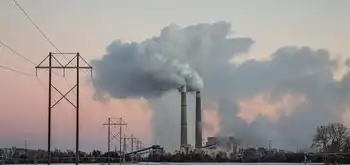Duke has right to cut trees on private property
MALLARD TRACE, NORTH CAROLINA - Two Mallard Trace homeowners hoping to save dozens of trees from the chainsaw got the decision they expected - but didn't want to hear - from the North Carolina Utilities Commission public staff.
Duke Energy does indeed have the right to cut trees on their property, staff member Jay Lucas e-mailed Bryan Holladay and Karen Bezanson. The message and attachments explain that Duke Energy, which is removing trees along a transmission line beside the neighborhood, has both the right and the obligation to take trees on private property near the line if the trees could damage the line if hey fell.
Holladay and Bezanson had insisted that Duke Energy not cut trees in their yards until it proved it had the authority. "It sounds like Duke can do pretty much what it wants," Bezanson said as she, her husband, Bruce, and Holladay read through the documents.
Several Mallard Trace residents came home from work May 21 to find Duke Energy door-hangers on their houses and orange spray-paint circles on trees in or near the utility's 68-foot-wide right of way near the Mallard Creek Greenway. The door hanger said the utility was maintaining the right-of-way to protect the lines, and that work crews would arrive the following Tuesday - the day after Memorial Day - to cut down trees bearing the orange paint.
Duke Energy's right of way cuts through several yards, but not Holladay's or the Bezansons', which share a copse of mostly young hardwoods. How could Duke Energy cut their trees, on their property, the owners wondered?
Longtime Mallard Trace residents also said this was the first time since the neighborhood was built about 1990 that Duke Energy had removed trees outside of the right of way.
Why cut now, Holladay and the Bezansons wondered? The Bezansons were particularly incensed. The couple bought their home because it backs up to the county greenway, Karen Bezanson said, and because it had a 30- to 40-foot-wide cluster of trees shielding it from the power lines and the afternoon sun.
The couple also paid for a property survey before they bought their home to make sure the yard lay outside the utility right-of-way. All except for perhaps a foot or two in one corner appears to be outside it. Since then, the Bezansons have cleared out some of the underbrush in the wooded area and created a shaded haven with a hammock and an extensive garden of shade-loving shrubs and flowers on the steep hillside above the power lines.
No trees in that improved area are marked for cutting. But once the marked trees go, the afternoon sun will pour into the formerly shaded backyard haven.
"I have no problem with them coming in and trimming," Bruce Bezanson said. And he certainly understands the need to protect the power line, he said. "But I don't know why they have to clear-cut, and you have no choice about it."
The neighbors put in calls first to Duke Energy and then to the public staff of the N.C. Utilities Commission. Duke Energy staff met with Holladay and Bezanson. Karen Bezanson said she and Holladay asked for proof that Duke Energy could cut on their land.
If the utility did have the right, the homeowners wanted the tree crews to trim where possible, rather than cut down. She said the response from the Duke energy staff was that the trees needed to come down.
Lucas' e-mail to the residents included rulings by the N.C. Utilities Commission that confirms Duke Energy's right to cut any trees within 16 feet of its right-of-way that might fall and take out a transformer line, and to cut trees farther away if they pose a risk, particularly if they are dead or ailing. Lucas also provided some context for why utilities have become more aggressive in protecting their transmission lines.
"In August 2003, a massive blackout occurred in the northeastern United States and Canada that can be partially attributed to transmission lines coming into contact with trees," Lucas wrote. "As a result of this blackout, the North American Electric Reliability Corporation (a utility oversight agency) issued the attached guidelines for transmission vegetation management and guidelines for penalties. These penalties are enforced," and the fines can reach $1 million a day.
Paige Sheehan, a spokesperson for Duke Energy, said the utility tries to help residents understand the need for this work.
"Our tree-trimming practices try to balance the need for people to keep their trees but also our requirement to keep the area safe," she said.
Karen Bezanson said she is "devastated" about losing her trees, "but we got what we really, really wanted, and that was the proof... to show they could do it. "And I will never live near another power line ever again," she added.
Related News

Report: Duke Energy to release climate report under investor pressure
HOUSTON - One of America’s largest utility companies, Duke Energy, is set to release a report later this month that sketches a drastically changed electricity mix in a carbon-constrained future.
The big picture: Duke is the latest energy company to commit to releasing a report about climate change in response to investor pressure conveyed by non-binding but symbolically important shareholder resolutions. Duke provides electricity to more than seven million customers in the Carolinas, the Midwest and Florida.
Gritty details: The report is expected to find that coal, currently 33% of Duke’s mix, gone entirely from its portfolio by 2050 in a future…




